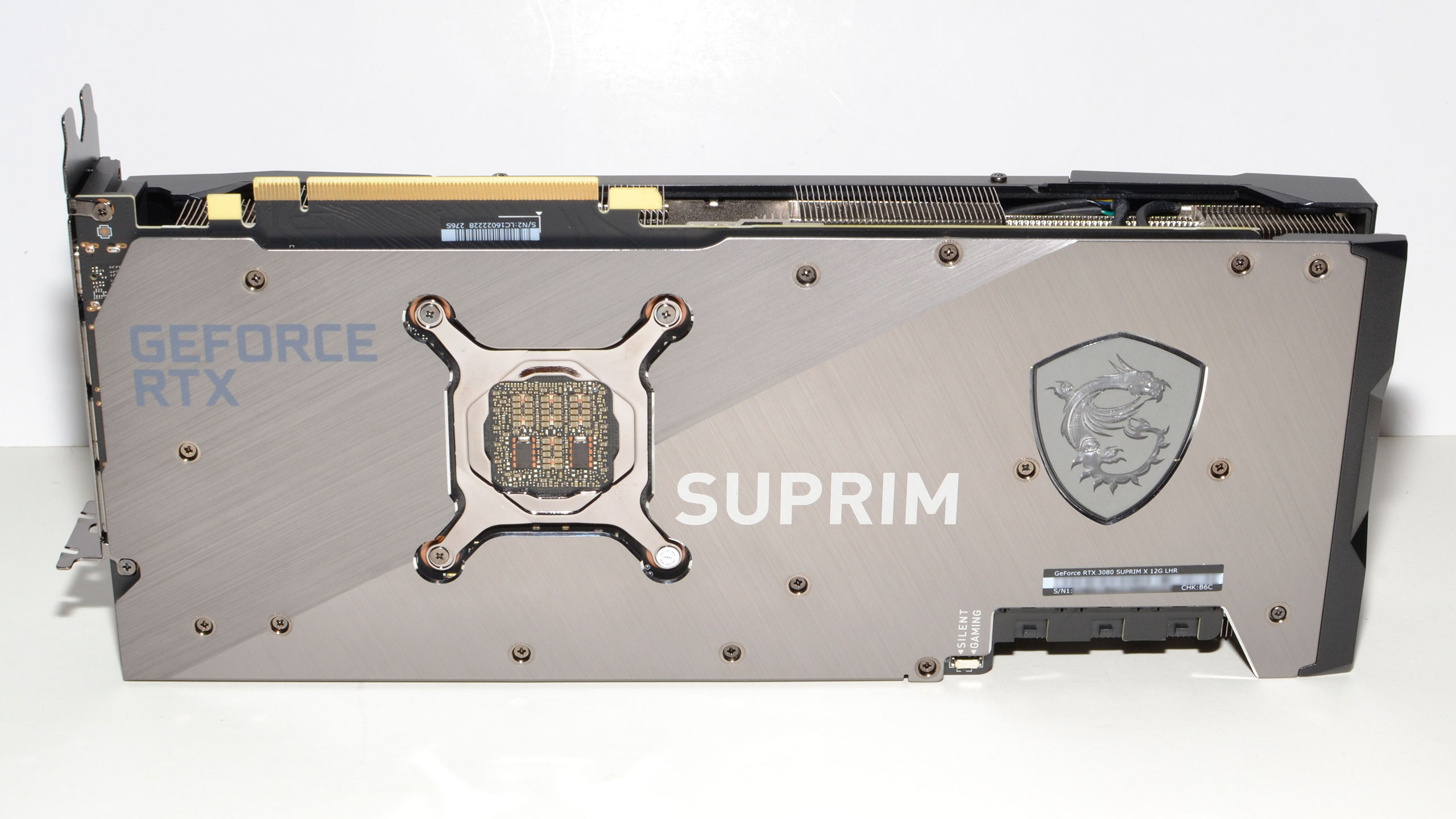Tom's Hardware Verdict
The MSI GeForce RTX 3080 12GB Suprim X managed to effectively tie the RTX 3080 Ti performance in most situations, thanks to its healthy factory overclock. Unfortunately, retail pricing looks equally high, which eliminates the one potential draw. It ends up as one more RTX 30-series model in an already crowded landscape, at a still-inflated price.
Pros
- +
+ 384-bit memory interface
- +
+ Large factory overclock
- +
+ Matches 3080 Ti in performance
Cons
- -
Same price as 3080 Ti
- -
Limited supply and high price
- -
High power draw
Why you can trust Tom's Hardware
The GeForce RTX 3080 12GB sits in a curious position. We heard various rumors about an updated RTX 3080 floating about before the official 'stealth' reveal, when Nvidia quietly updated its RTX 30-series specs page. Will the RTX 3080 12GB manage to land a spot among the best graphics cards? Where does it fit into the GPU benchmarks hierarchy? What will supply look like, and how much will the cards cost? These are all important questions, and we received the MSI GeForce RTX 3080 12GB Suprim X that will provide at least some answers.
There were earlier suggestions that Nvidia would double down on the memory but keep the same RTX 3080 GPU configuration. Others promised a 12GB 3080 with regular GDDR6 memory, and the third and apparently correct variant was a slightly higher GPU core count with 12GB of GDDR6X memory. That description basically matches the GeForce RTX 3080 Ti, however, which makes us wonder why this particular GPU was even needed.
Nvidia told us that the RTX 3080 12GB was a SKU requested by its add-in board (AIB) partners, so there won't be any Founders Edition of the card. That also means there's no reference price from Nvidia and the AIB partners can decide for themselves how much to charge. Given the similarity in specs to the RTX 3080 Ti, most AIBs appear to be charging $1,200 or more. Let's take a look at the specs for some competing graphics cards.
| Graphics Card | MSI RTX 3080 12GB Suprim X | RTX 3080 10GB | RTX 3080 Ti | RX 6900 XT |
|---|---|---|---|---|
| Architecture | GA102 | GA102 | GA102 | Navi 21 |
| Process Technology | Samsung 8N | Samsung 8N | Samsung 8N | TSMC N7 |
| Transistors (Billion) | 28.3 | 28.3 | 28.3 | 26.8 |
| Die size (mm^2) | 628.4 | 628.4 | 628.4 | 519 |
| SMs / CUs | 70 | 68 | 80 | 80 |
| GPU Cores | 8960 | 8704 | 10240 | 5120 |
| Tensor Cores | 280 | 272 | 320 | N/A |
| RT Cores | 70 | 68 | 80 | 80 |
| Boost Clock (MHz) | 1845 | 1710 | 1665 | 2250 |
| VRAM Speed (Gbps) | 19 | 19 | 19 | 16 |
| VRAM (GB) | 12 | 10 | 12 | 16 |
| VRAM Bus Width | 384 | 320 | 384 | 256 |
| ROPs | 96 | 96 | 112 | 128 |
| TMUs | 280 | 272 | 320 | 320 |
| TFLOPS FP32 (Boost) | 33.1 | 29.8 | 34.1 | 23 |
| TFLOPS FP16 (Tensor) | 132 (264) | 119 (238) | 136 (273) | N/A |
| Bandwidth (GBps) | 912 | 760 | 912 | 512 |
| TDP (watts) | 400 | 320 | 350 | 300 |
| Launch Date | Jan-22 | Sep-20 | Jun-21 | Dec-20 |
| Official MSRP | $1,249 | $699 | $1,199 | $999 |
| eBay Price (Early 2022) | $1,576 | $1,523 | $1,774 | $1,510 |

While the RTX 3080 Ti has quite a few more GPU cores, SMs, etc., the MSI 3080 12GB sports much higher boost clocks, negating most of the difference. Of course a factory overclocked 3080 Ti would widen the gap again, but either way we're looking at the same memory configuration and bandwidth, which should be a major factor in determining overall performance. Compared to the original 3080, the 12GB card adds just one more SM cluster (Nvidia can only disable SMs in groups of 2), but the 20% increase in memory and memory bandwidth should prove more useful.
Based on the specs, we suspect the real reason for the RTX 3080 12GB goes back to the GA102 chip yields. If Nvidia is getting a decent number of chips with all 12 memory controllers working, but with more than 4 SM clusters than are non-functional, it can't sell those chips for 3080 Ti cards. By dropping down to just 70 SMs, the GPUs can still be used in more expensive cards than the baseline RTX 3080 10GB.
We've included both the MSRPs as well as the typical GPU prices from eBay for the past month. The former is of course completely meaningless right now, but we're happy to see that the 12GB 3080 only costs a bit more than the regular 3080. Part of that comes from the fact that there are still non-LHR 3080 10GB cards in the wild, which tend to go for a premium, but all the 3080 Ti cards are LHR models, as are the 3080 12GB cards, so it looks like you can expect to save perhaps $200 right now by purchasing a 3080 12GB instead of the 3080 Ti.
Note also that the Radeon RX 6900 XT tends to go for a similar price to the RTX 3080, so that will be a good point of comparison. Nvidia theoretically delivers much higher compute performance and memory bandwidth, but AMD provides more memory, and the large 128MB Infinity Cache helps to keep things much closer than the above specs would suggest.
- MORE: Best Graphics Cards
- MORE: GPU Benchmarks and Hierarchy
- MORE: All Graphics Content
Jarred Walton is a senior editor at Tom's Hardware focusing on everything GPU. He has been working as a tech journalist since 2004, writing for AnandTech, Maximum PC, and PC Gamer. From the first S3 Virge '3D decelerators' to today's GPUs, Jarred keeps up with all the latest graphics trends and is the one to ask about game performance.
-
King_V Reply"You know, we have a lot of GA102 chips where all 12 memory controllers are perfectly fine but where we can't hit the necessary 80 SMs for the 3080 Ti. Rather than selling these as an RTX 3080 10GB, what if we just make a 3080 12GB? Then we don't have to directly deal with the supposed $699 MSRP."
That may not be exactly what happened, but it certainly feels that way. MSI has produced a graphics card that effectively ties the RTX 3080 Ti in performance, even though it has 10 fewer SMs and needs more power to get there.
I guess that's one way to hit the price point and raw performance metrics. -
10tacle THANK YOU Jared for including FS2020 in this hardware review! That's pretty much all I use my rig for as a hard core flight simmer. I find the gap increase at 4K with the 3080 Ti (my GPU) over this 10GB 3080 interesting. That sim is a strange hardware demand duck and I'm still trying to figure out fine tuning details some 6 months on now since my build last August after winning a NewEgg shuffle to get the GPU (I paid $1399.99 for the EVGA FTW3 edition).Reply
The interesting thing is that it is the only game (sim to me) that shows a leg stretch gap between the lower tiered/VRAM'd cards, including this 10GB 3080, at 4K. My guess is that's where the Ti's wider memory bus bandwidth, CUDA cores (I still call Nvidia GPU cores that), and extra 2GB VRAM come together to show off the power of the GPU. The same can be said with the 3090 sitting at the top of the FS2020 chart at 4K. -
HideOut I hope the Intel ARC series is competitive and they put so much price pressure on nVidia that they nearly go broke. They're doing noithing but ripping off customers these days with this kinda rediculous trash.Reply -
watzupken I actually see no point in paying this much for a RTX 3000 series card when we are expecting RDNA3 and RTX 4000 series to be announced later this year. I feel Nvidia released this card with the intention of increasing prices, less to push performance. After all, between RTX 3080 and RTX 3090, each "new" product is just marginally better than the previous, but cost quite a bit more for a few % improvement.Reply -
JarredWaltonGPU Reply
Like I said in the review, Nvidia claims this was an AIB-driven release. Meaning, MSI, Asus, EVGA, Gigabyte, etc. wanted an alternative to the 3080 Ti and 3080 10GB. Probably there were chips that could be used in the "formerly Quadro" line that have similar specs of 70 SMs and 384-bit memory interface, and Nvidia created this SKU for them to use. But that would assume there's less demand for the professional GPUs right now, as otherwise Nvidia would presumably prefer selling the chips in that more lucrative market.watzupken said:I actually see no point in paying this much for a RTX 3000 series card when we are expecting RDNA3 and RTX 4000 series to be announced later this year. I feel Nvidia released this card with the intention of increasing prices, less to push performance. After all, between RTX 3080 and RTX 3090, each "new" product is just marginally better than the previous, but cost quite a bit more for a few % improvement.
